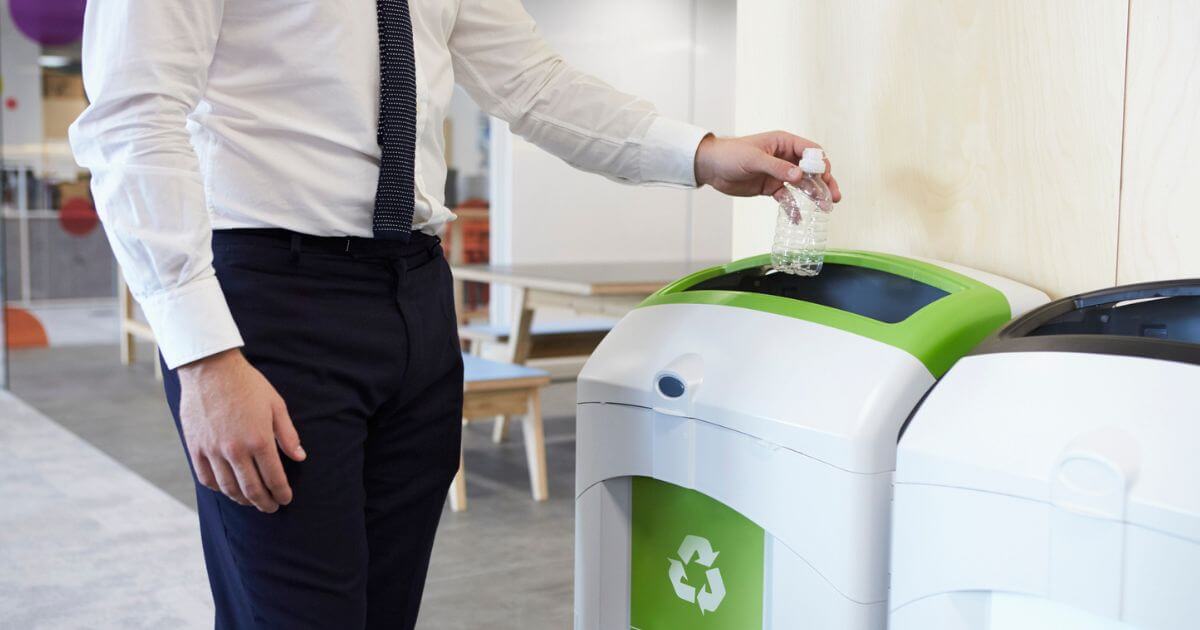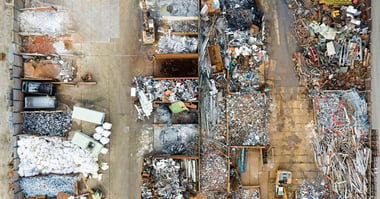
Maura Monaghan
Maura Monaghan has been a digital writer for five years now, covering everything from sustainable ecommerce to types of plastic. She's interested in ecommerce, sustainability, and the ways they can overlap. When she's not writing, she's probably out searching for the perfect cup of coffee.
There’s no one way to describe how recycling works in America – for a country so large, systems differ by state and town. But there are common weaknesses in the amount of plastic produced across the US, and how it gets disposed of — all of which contribute to the current American recycling rate of 32%.
In this article, we’ll explain the factors that contribute to that low rate, break it down by state, and explore what American recycling might look like in a better future.
Want to reduce your business’s plastic footprint? We can help. All you have to do is get in touch with our in-house team. Once we’ve received your details, we can arrange a call to discuss which plastic recovery plan will suit your business needs best.
What’s on this page?
01 | How does the American recycling system work?
02 | Challenges of recycling in America
03 | American recycling rates
04 | Attitudes towards recycling in America
05 | What does the future of recycling in America look like?
06 | Summary
07 | FAQs
How does the American recycling system work?
There is no national law that mandates recycling in America, so the rules and requirements differ according to state and even local governments. Sometimes states work together with non-profit organizations to create their own recycling programs, including Washington and Colorado.
Still, the general three-step process is typically collection, processing, and remanufacturing into a new product. But different states take different approaches to encouraging people to recycle more.
Some states, including Minnesota, North Carolina, and Wisconsin, have implemented landfill bans on recycling materials, while some cities have created mandatory recycling laws for both individuals and corporations, such as San Diego’s Recycling Ordinance and Austin’s Universal Recycling Ordinance. These laws are enforced by charging a fine for throwing away recyclable materials.
These actions can be monitored by dispatching inspectors to trash haul sites to see if recyclable materials are mixed in with the garbage.
Many US states have also introduced “bottle bills,” or container deposit laws. Under these laws, most states refund five to ten cents back on recycled cans and bottles.
Do Americans have curbside recycling?
Yes – 73% of Americans have access to some form of curbside recycling, and about half of the country is enrolled in the program automatically.
6% of the curbside recycling group has to opt in to receive it, while 14% of the programs are subscription-based.
In these figures, “opting in” is defined as a situation where a household has one potential curbside provider, and must contact them to be enrolled. Subscription-based programs offer a number of service providers, and households then secure their own contractors.
Is waste collection free in America?
Most municipalities in America provide waste collection to residents, but they are usually required to pay for these services through taxes or utility bills.
The breakdown of costs will vary depending on factors like the frequency of collection, the amount of recyclable waste generated, and local regulations. Even within each state, costs will differ – for example, Albany, NY charges a $90 annual fee for all waste collection pickup, while nearby Troy, NY charges $254 per year.
Challenges of recycling in America
70% of Americans name recycling as the number one thing they do to help the environment, but that sentiment doesn’t translate into a lot of action: according to the US Environmental Protection Agency, only 32% of waste gets recycled or composted.
Inconsistent programs across states and locales are a contributing factor to these low numbers. The decentralized nature of America’s recycling programs can lead to confusion and people not knowing how or where to begin sorting their materials and figuring out which ones can be recycled.
Even once materials are out of individuals’ hands, the challenges continue – contamination of recyclables, due to improper sorting or disposal, reduces the effectiveness of Americans’ recycling efforts by placing those materials in landfills.
It will take collaboration across organizations and municipalities to address the challenges facing the system.
In addition to confusion for individuals, there’s also the problem of the country’s recycling infrastructure, which has not kept pace with today’s waste stream. Americans generated 2.68 lbs of waste per day in 1960, compared to 4.51 pounds in 2017. The country’s recycling services must scale to keep pace with that waste generation.
And for materials that are recycled, there is a lack of domestic markets for their reintroduction into the buying cycle. New international policies have limited the export of recycled materials, so there is a greater need for the development of “existing materials” markets within the US.

American recycling rates
According to Yale University’s Environmental Performance Index (EPI), the United States ranks 105th out of 179 countries in its recycling rate (which hovers around 32%, as we mentioned above).
America’s EPI score of 51.1 is low compared to other countries with similar GDP per capita, like Denmark (EPI score of 77.9) and Sweden (EPI score of 72.7).
Its score sits in the middle of the pack for G20 countries, of which Germany tops the charts with a 62.4 and Argentina finishes last with a 41.1.
How much plastic does America recycle?
Globally, only 9% of plastic waste is recycled – and America has an even lower rate, of just 5%.
The amount of plastic waste generated annually per person is also very high in the US, at 221 kg compared to 114 kg in European OECD countries, and an average of 69 kg in both Japan and Korea.
America’s poor performance in plastic recycling can best be explained by the combined factors of unscalable infrastructure, unclear labeling of products for sorting, and a lack of investment in sustainable alternatives to single-use plastics.
If you want to learn more about these trends, our Plastic Perspectives Report 2024 has plenty of information about recycling attitudes in America.
A breakdown of the best states for recycling
Successful states when it comes to recycling have a few things in common: widespread public awareness campaigns, strong recycling programs, and solid governmental support for these initiatives.
Below are the ten best US states for recycling, according to a Ball Corporation study on recycling rates for common container and packaging materials (CCPM) in the US:
|
Rank |
State |
CCPM recycling rate |
|
1 |
Maine |
72% |
|
2 |
Vermont |
62% |
|
3 |
Massachusetts |
55% |
|
4 |
Oregon |
55% |
|
5 |
Connecticut |
52% |
|
6 |
New York |
51% |
|
7 |
Minnesota |
49% |
|
8 |
Michigan |
48% |
|
9 |
New Jersey |
46% |
|
10 |
Iowa |
44% |
A breakdown of the worst states for recycling
States with lower recycling rates often struggle due to limited access to programs, inadequate infrastructure, and a lack of public awareness campaigns. According to the same study, these are the worst states in America for recycling:
|
Rank |
State |
CCPM recycling rate |
|
50 |
Alaska |
16% |
|
49 |
Mississippi |
17% |
|
48 |
Tennessee |
22% |
|
47 |
Alabama |
22% |
|
46 |
Ohio |
27% |
|
45 |
Kentucky |
24% |
|
44 |
Louisiana |
26% |
|
43 |
New Mexico |
27% |
|
42 |
Arkansas |
28% |
|
41 |
Oklahoma |
29% |
Attitudes towards recycling in America
We wanted to learn more about the trends and mindsets around recycling in America, so we surveyed 965 people across the country to create our Plastic Perspectives Report 2024.
The findings revealed that many people know recycling is beneficial, and try to do it wherever possible – 87% of respondents said they recycle at home. But even for the informed consumer, it’s proving difficult to find opportunities to recycle.
One-third of people surveyed find it impossible to avoid single-use plastics, while three-quarters said they want the US government to make recycling more accessible.
Based on the people we surveyed, it seems that there’s a desire among Americans for more incentives, education, and general awareness about plastic recycling.
What does the future of recycling in America look like?
According to our survey findings, the appetite for recycling in America exists; it’s the infrastructure and availability that need to keep up!
Sustainability is becoming an increasing priority for consumers, businesses, and government agencies alike – 50% of investors are increasing their environmental, social, and governance (ESG) investments, while 44% of consumers are more likely to buy from a sustainable brand.
Moving forward, hopefully the rising tide of pro-recycling sentiment will lead to more incentives, education, and opportunities for recycling in America.
Summary
Recycling in America isn’t simple, but it is something that individuals and businesses appreciate the importance of and want to pursue.
Fragmentation across states and cities, as well as a lack of domestic markets for recycled materials, pose challenges to the uptake of recycling in America. However, individuals want to make the effort, and consumers want to patronize businesses that make the effort, too.
CleanHub can help you reduce your business’s plastic footprint. All you have to do is get in touch with our in-house team – once we’ve received your details, we can arrange a call to discuss which plastic recovery plan will suit your business needs best.
FAQs
Do Americans support recycling?
According to our survey findings, yes! 87% of Americans we surveyed said they recycle at home, indicating widespread support. Access to recycling services varies throughout the country, which seems to be the biggest barrier to a higher recycling rate.
Why is recycling in the US broken?
Americans are generally enthusiastic about recycling, but often lack the access to proper recycling facilities and services that they would need in order to make it a long-lasting, impactful habit.
Is recycling mandatory in the US?
Recycling is not mandatory in the US. However, some states and cities are introducing laws and incentives to encourage recycling, such as bottle refund schemes and fines for plastic waste.

.webp)

.webp?width=380&name=landfill%20(2).webp)

.webp?width=380&name=CleanHub-waste-sorters-%20(1).webp)
.webp?width=380&name=Recycling-plant%20(1).webp)

.png?width=380&name=CleanHub%20Bcorp%20(1).png)
.webp?width=380&name=wave%20(1).webp)
%20(1).webp?width=380&name=Summer%20(1)%20(1).webp)
.webp?width=380&name=warehouse%20(1).webp)
